A good retirement portfolio is diversified and dividend-focused. Diversification is important financial defense, but dividends are your financial offense.
They compound on themselves because companies that pay dividends have an implied agreement with their shareholders that they’ll continue bumping them up.
[ad#Google Adsense 336×280-IA]Not all do, of course – but I’ve identified five dividend growth stocks that you can bank on.
Today they yield an average 3.6% and each has not only a strong history of increasing dividends but also strong dividend coverage – which means their payouts (and stock prices) are likely to keep growing for the foreseeable future.
Now let’s get into these five dividend growers…
They are General Motors (GM), Target (TGT), Pfizer (PFE), Edison International (EIX) and Phillip Morris (PM).
You might be averse to buying a cigarette stock, but bear with me—you won’t regret it.
Strong Dividend Yields
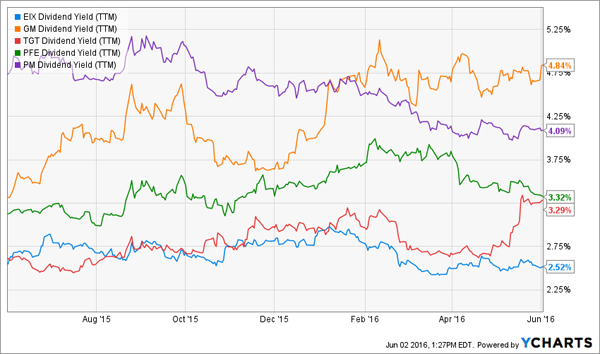 These stocks have yields between 2.5% and 5%, which have mostly ticked upwards lately thanks to a mix of price weakness and dividend growth. That’s a great combination for people looking to buy in right now, especially since none of these companies is showing any signs of long-term business weakness.
These stocks have yields between 2.5% and 5%, which have mostly ticked upwards lately thanks to a mix of price weakness and dividend growth. That’s a great combination for people looking to buy in right now, especially since none of these companies is showing any signs of long-term business weakness.
A Short-Term Price Dip
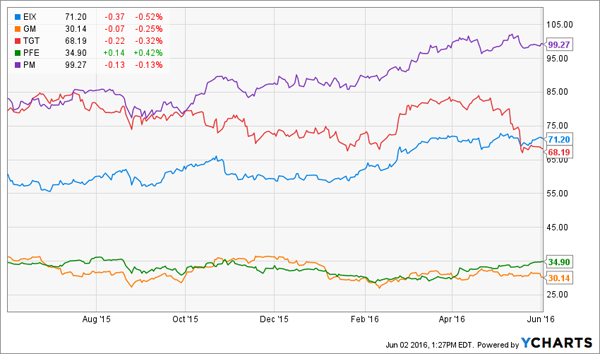 GM has the highest yield, thanks in part to the stock falling from over $40 to near $30 in 2016. That decline is despite the company’s healthy revenue growth of 4.3% and growing cash from operating activities—which rose 19% in 2015 from the prior year. The company is a heavy investor in itself, having increased its stock buyback program by 80% at the beginning of this year. Fewer outstanding shares makes it even easier for GM to cover its dividend – and more likely to boost it going forward.
GM has the highest yield, thanks in part to the stock falling from over $40 to near $30 in 2016. That decline is despite the company’s healthy revenue growth of 4.3% and growing cash from operating activities—which rose 19% in 2015 from the prior year. The company is a heavy investor in itself, having increased its stock buyback program by 80% at the beginning of this year. Fewer outstanding shares makes it even easier for GM to cover its dividend – and more likely to boost it going forward.
The same goes for Target. Last year the retailer announced it would buy back $10 billion of its own stock, which is a whopping 25% of the current shares outstanding. The company also boosted dividends by 7.7% exactly one year ago. And, given the company’s history of boosting payouts in June, the 7.1% increase earlier this week was hardly a surprise.
Current Pricing and Future Price Growth
Each of these companies is affordably priced. When we look at their price-to-earnings (P/E) ratios, we see an average far below the S&P 500’s 24 (which is itself a frightening 65% above its historical average).
Cheap Stocks with Great Payouts…
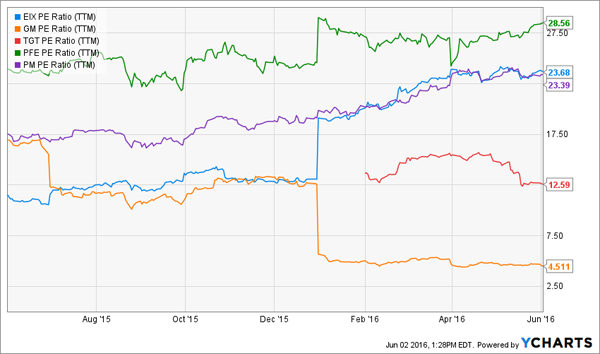 The range of P/E ratios in these stocks is substantial, partly reflecting different attitudes towards different industries. However, GM’s P/E ratio is just silly. Right now, the company is growing EPS more than any other of these five companies, and has seen EPS grow at a high rate over the last year:
The range of P/E ratios in these stocks is substantial, partly reflecting different attitudes towards different industries. However, GM’s P/E ratio is just silly. Right now, the company is growing EPS more than any other of these five companies, and has seen EPS grow at a high rate over the last year:
… and Rising Earnings
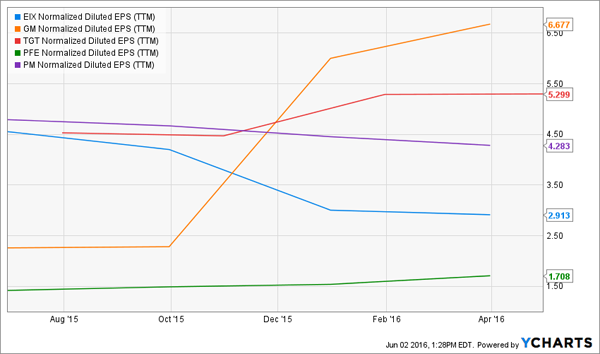 Pfizer is the only stock with a P/E ratio higher than the S&P 500. But it boasts high growth prospects thanks to its robust product pipeline – which should fuel future profit and dividend growth. Remember, when investing in pharmaceutical companies, it’s all about the pipeline.
Pfizer is the only stock with a P/E ratio higher than the S&P 500. But it boasts high growth prospects thanks to its robust product pipeline – which should fuel future profit and dividend growth. Remember, when investing in pharmaceutical companies, it’s all about the pipeline.
Investors might be surprised to see a high P/E ratio for Phillip Morris. Aren’t people smoking less? Well, yes, they are:
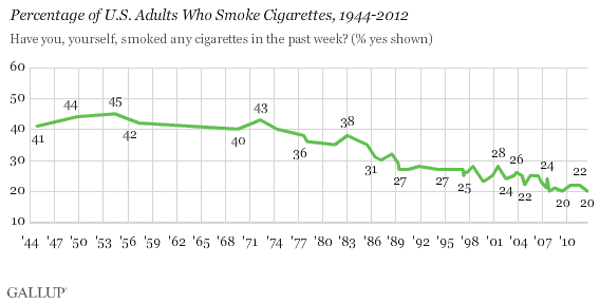 That doesn’t mean Phillip Morris is doomed, though. The company has invested in higher margin products like e-cigarettes and continues to expand globally.
That doesn’t mean Phillip Morris is doomed, though. The company has invested in higher margin products like e-cigarettes and continues to expand globally.
Plus, Phillip Morris can continue its share buyback activity. The company bought $12.7 billion in shares from 2012 to 2015. And the company’s $7.8 billion free cash flow is more than enough to pay the $1.6 billion in annual dividend payouts to shareholders while continuing its tradition of annual dividend increases.
Diversification
This portfolio provides not only yield and earnings growth, but it’s also diversified:
Dividend Growth Portfolio by Sector
 These five companies cover a variety of sectors, providing exposure to different industries that don’t necessary decline or grow at the same time. This means we can rebalance the portfolio easily when needed to keep an even allocation and take profits from the cyclical outperformers and invest them when other sectors are a bit sluggish.
These five companies cover a variety of sectors, providing exposure to different industries that don’t necessary decline or grow at the same time. This means we can rebalance the portfolio easily when needed to keep an even allocation and take profits from the cyclical outperformers and invest them when other sectors are a bit sluggish.
This is a long-term game; buying and holding these stocks, rebalancing annually and waiting for dividends to grow will provide us with substantial compounding of both our initial investment and our dividends. This means we can buy these stocks and keep them for years, even decades, and not have to worry about a volatile and stressed market. To demonstrate this, just look at these stocks’ performance in 2008-2010:
Our Dividend Stocks in the Dark Days of 2008-09
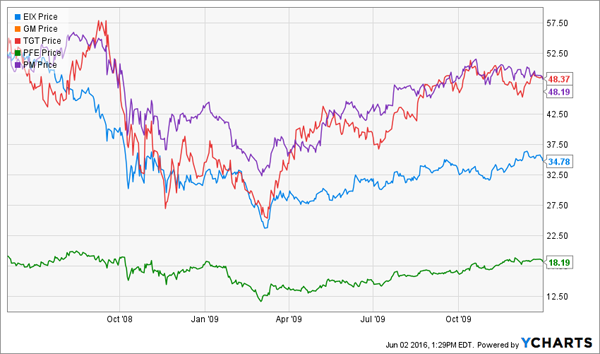 When the market was panicking, these stocks suffered too, but recovered fairly quickly. People who held through the storm and bought more were rewarded with more stock, more dividends and more capital gains. When the next crisis hits (as it always does), these stocks will likely experience a similar decline and recovery.
When the market was panicking, these stocks suffered too, but recovered fairly quickly. People who held through the storm and bought more were rewarded with more stock, more dividends and more capital gains. When the next crisis hits (as it always does), these stocks will likely experience a similar decline and recovery.
Conclusion & 3 Bonus Picks
The compounding power of dividend growth, combined with buying and holding these shares and reinvesting your dividends, will help your investments compound aggressively in good times and bad. Diversifying a dividend portfolio across sectors also gives you a chance to rebalance and take advantage of cyclical mini-corrections that one sector suffers while another thrives.
There’s a catch, of course: you need to stay the course, tolerate the bad times, and keep tabs on your portfolio.
— Brett Owens
Sponsored Link: Of course, you don’t want to stick to just these stocks, though. In addition to high dividend stocks, you should also buy some high dividend bonds that can boost your portfolio’s yield to 8%,and beyond. But bonds are complicated, and not all that easy to buy, especially in a retirement account.
Fortunately, there are a small group of little-known bond funds that yield over 8% that also have great dividend coverage and strong future payout potential. That’s why they’re loved by billionaire “Bond God” Jeffrey Gundlach and dozens of other ultra-wealthy investors looking to turn their heaps of cash into reliable income. If you want to learn more about these funds, click here and I’ll explain more.
Source: Contrarian Outlook



